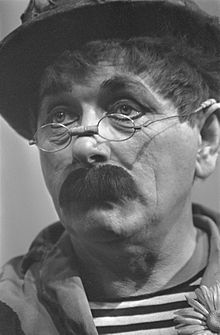Tom Manders (Dutch artist)
| Tom Manders | |
|---|---|
 |
|
| Background information | |
| Birth name | Antoon (Tom) Manders |
| Also known as | Dorus |
| Born |
October 24, 1921 The Hague, Netherlands |
| Died | February 26, 1972 (aged 50) Utrecht, Netherlands |
| Years active | 1953–1971 |
Antoon (Tom) Manders was a Dutch artist, comedian and cabaret performer. In later role, he became better known as Dorus.
Although his birth was officially recorded as having happened on October 24, he was actually born on the 23. His father had him registered one day later because, for a child born on Sunday, he would not get a day off work.
Already at a young age, his talent for drawing became apparent. He attended the Royal Academy of Art in The Hague, Netherlands for 3 years and was active, among other things, as an advertisement painter and designer of posters. Later he also designed decors for theatre and cabaret, regularly for Lou Bandy, Wim Kan and theatre Carré in Amsterdam.
During World War II, Manders had to work in Germany but after half a year, he fled from his job as a painter. Because of Wim Kan, Manders got the idea to start doing cabaret himself, like his older brother Kees.
Starting in 1953, Manders was involved with the design of Carel Kamlag's cafe Saint-Germain-des-Prés at the Rembrandtplein in Amsterdam. Manders performed there himself as a vagabond, a role that would later become famous as Dorus. When VARA offered him an opportunity to perform on television, he had the cafe copied in the studio and started a successful show that would be broadcast for several years.
Between 1956 and 1962, Manders worked together with organist Cor Steyn for the program De Showboat. Together they created tracks like Twee motten (two moths), Als ik wist dat je zou komen (had I known you would come by) en Bij de marine (in the navy).
Manders got into financial trouble when he tried to produce Dorus movies. In 1967, he won the Zilveren Roos prize and started a new program, Bij Dorus op schoot (on Dorus' lap). In a particularly famous scene from November 18, a young girl tries to sing the famous Dutch children song Poessie Mauw, of which she endlessly repeated only the title.
...
Wikipedia
